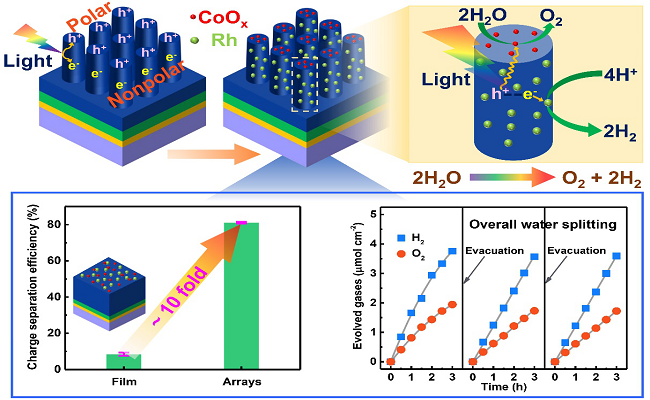[ Instrument Network Instrument Research and Development ] Recently, Li Can, a researcher of the State Key Laboratory of Catalysis, Dalian Institute of Chemical Physics, Chinese Academy of Sciences, and researcher Li Rengui, together with Yan Jianchang, a researcher at the Institute of Semiconductors of the Chinese Academy of Sciences, have made new achievements in photothermal charge separation research in artificial photosynthetic systems. Progress: The discovery of a polarity-induced surface electric field effectively promotes the spatial separation of photogenerated charges and greatly enhances the activity of photocatalytic total decomposition water.

In addition to crystal morphology and crystal planes that can be used to regulate photo-generated charge separation, surface polarity characteristics are an extremely common and common material intrinsic property for most semiconductor materials, however, for intrinsic polarity of semiconductor materials. The rational design and regulation and its effect on the separation of photogenerated charges remain unclear. In this work, the researchers selected representative semiconductor gallium nitride (GaN) as a model, and fabricated a gallium nitride nanorod array structure with clear surface polarity characteristics by metal organic vapor deposition method. The array structure exposed the top polarity respectively. Surface and vertical lateral non-polar planes have been found to exhibit significant photo-generated charge separation characteristics between the polar and non-polar planes of GaN nano-array structures. Photogenerated electrons selectively aggregate on the non-polar surface of the nanorods. And the photogenerated holes gather on the polar side. This is because the surface dipole moments of the polar surface and the non-polar surface are different, and different surface electric fields are induced to be formed, thereby driving selective migration of photogenerated electrons and holes, thereby realizing effective separation of photogenerated charges. Furthermore, it was found by photoelectrochemistry and photocatalytic reaction that the photo-generated charge separation efficiency of GaN nanorods with polar and non-polar planes exceeded 80%, which was more than ten times higher than that of GaN thin films. The highest value of charge separation efficiency. At the same time, based on the photo-generated charge separation effect between the polar and non-polar planes, the quantum efficiency of photocatalytic complete decomposition of water can be increased from 0.9% to the redox double promoter. 6.9%. This work proposes a new strategy for photo-electric charge separation, which lays a theoretical foundation for constructing an efficient artificial photosynthetic system. At the same time, it provides a new way to further deepen the understanding and understanding of the essential driving force of photo-generated charge separation.
Artificial photosynthetic is a "holy cup" scientific subject in the field of international science. Photogenerated charge separation is the core scientific problem of artificial photosynthetic solar fuel. Designing and developing efficient photogenerated charge separation strategy to promote the separation and transmission of photogenerated charge is always a hot topic in this research field. difficulty. The Li Can team has long been committed to the frontier scientific issues of artificial photosynthetic solar fuels, and has made a series of progresses, and has proposed a heterogeneous junction charge separation mechanism (Angew. Chem. Int. Ed., 2008; Angew. Chem. Int. Ed., 2012 ), found that the photo-generated charge separation effect between crystal faces (Nat. Commun. 2013), developed a photo-generated charge separation strategy for high-symmetry semiconductor materials (Energy Environ. Sci. 2016), and independently developed a new photo-energy imaging characterization technology ( Angew. Chem. Int. Ed., 2015; Nat. Energy, 2018), has received extensive attention from academia.
The research results "Surface polarity-induced spatial charge separation boosting photocatalytic overall water splitting on GaN nanorod arrays" were published online in the form of Full Article in German Applied Chemistry. The research work was supported by the Chinese Academy of Sciences' Clean Energy Pilot Science and Technology Project, the Chinese Academy of Sciences major research project, and the National Natural Science Foundation.
uPVC window milling machines are used to process hardware installation holes and slots, water slots, air-pressure balance grooves and other holes or slots in uPVC windows and doors, and it is an important component part of uPVC window production line. Milling hardware holes or slots and water-slots of windows is an important step in window-door manufacturing procedure. The quality of these holes or slots will have a direct influence on the quality of windows and doors. Qualified hardware holes and slots not only improve the visual sense of beauty of uPVC windows and doors, but guarantee the fastness and durability of hardware which increases the safety factor of windows and doors. uPVC window milling machines include water slot milling machine, lock hole & slot milling machine, copy routing machine, and so on.
UPVC Milling Machine
Upvc Milling Machine,Aluminum Profile End Milling Machine,Upvc Aluminium End Milling Machine,Upvc Milling Machine For Aluminum Window
Jinan Stone Machine Co., Ltd. , https://www.jnstonema.com
